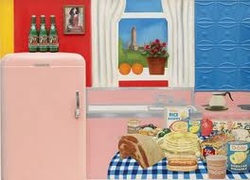MoMA - Museum of Modern Art presents . . .
Counter Space . . .design + the modern kitchen

design + the modern kitchen
Meal machine, experimental laboratory, status symbol, domestic prison, or the creative and spiritual heart of the home? Over the course of the past century no other room has been the focus of such intensive aesthetic and technological innovation, or as loaded with cultural significance. Kitchen design has been both a central concern of modernism and fundamental to our concept of modern life. Drawn entirely from MoMA’s collection, this exhibition explores the twentieth-century transformation of the kitchen as a barometer of changing technologies, aesthetics, and ideologies.
The text in this section is taken directly from the web site of the Museum of Modern Art, so that the information will continue to be available after the exhibit is over. The links in the text below are to the sections on the MoMA web site. However they are also available in the drop down menu on this web site.
The New Kitchen, an interwar design concept that embodied modernist principles of efficiency, hygiene, and standardization, appeared in numerous iterations throughout Europe and the United States. These modern kitchens reflected an idealistic faith in the transformative power of art and technology to effect social change. The iconic Frankfurt Kitchen, designed by Margarete (Grete) Schütte-Lihotzky, was mass-produced for public housing estates in the aftermath of World War I. An unusually complete example, recently acquired, is displayed exhibition for the first time.
Visions of Plenty examines how the innovations of Schütte-Lihotzky’s generation were extended and modified after World War II by the consumer revolution and Cold War politics. It was also during these years that “dream kitchens” emerged as sites for selling ideas of creative leisure and futuristic fantasy.
Kitchen Sink Dramas offers psychologically nuanced views of lived experience in this hub of domestic activity—its nightmares and delights—seen in works of art made since the 1960s.
http://www.moma.org/interactives/exhibitions/2010/counter_space
Meal machine, experimental laboratory, status symbol, domestic prison, or the creative and spiritual heart of the home? Over the course of the past century no other room has been the focus of such intensive aesthetic and technological innovation, or as loaded with cultural significance. Kitchen design has been both a central concern of modernism and fundamental to our concept of modern life. Drawn entirely from MoMA’s collection, this exhibition explores the twentieth-century transformation of the kitchen as a barometer of changing technologies, aesthetics, and ideologies.
The text in this section is taken directly from the web site of the Museum of Modern Art, so that the information will continue to be available after the exhibit is over. The links in the text below are to the sections on the MoMA web site. However they are also available in the drop down menu on this web site.
The New Kitchen, an interwar design concept that embodied modernist principles of efficiency, hygiene, and standardization, appeared in numerous iterations throughout Europe and the United States. These modern kitchens reflected an idealistic faith in the transformative power of art and technology to effect social change. The iconic Frankfurt Kitchen, designed by Margarete (Grete) Schütte-Lihotzky, was mass-produced for public housing estates in the aftermath of World War I. An unusually complete example, recently acquired, is displayed exhibition for the first time.
Visions of Plenty examines how the innovations of Schütte-Lihotzky’s generation were extended and modified after World War II by the consumer revolution and Cold War politics. It was also during these years that “dream kitchens” emerged as sites for selling ideas of creative leisure and futuristic fantasy.
Kitchen Sink Dramas offers psychologically nuanced views of lived experience in this hub of domestic activity—its nightmares and delights—seen in works of art made since the 1960s.
http://www.moma.org/interactives/exhibitions/2010/counter_space
